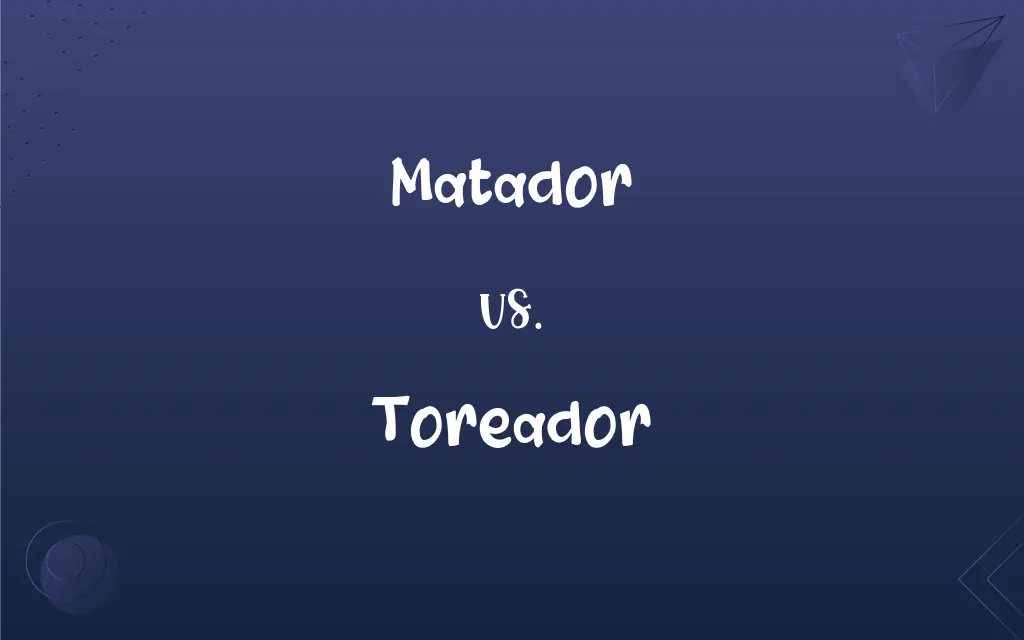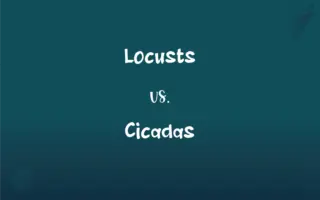Matador vs. Toreador: What's the Difference?
Edited by Janet White || By Harlon Moss || Updated on November 15, 2023
A matador is the main bullfighter who performs the final kill, while toreador is a general term for a bullfighter, often used in literature and art.

Key Differences
A matador is a specific role in Spanish bullfighting, traditionally responsible for killing the bull in the arena. This role is central to the bullfight and requires significant skill and training. Toreador, on the other hand, is a more general term for bullfighters and is not typically used in Spain. It gained popularity through art and literature, notably in Bizet's opera "Carmen."
The matador performs the final and most dangerous part of the bullfight, facing the bull in a one-on-one challenge. Their skill is judged by their ability to kill the bull with a single sword thrust. In contrast, a toreador can refer to any participant in the bullfighting event, including those who assist the matador but do not perform the kill.
Matadors are celebrated figures in Spanish culture, often achieving celebrity status. Their role is steeped in tradition and requires a deep understanding of bullfighting techniques. Toreadors, as represented in popular culture, are often romanticized and can refer to any bullfighter, regardless of their specific duties in the ring.
The term matador is derived from the Spanish word "matar," meaning "to kill," signifying their role in the bullfight. Toreador, while less precise, is evocative of the spectacle and drama of bullfighting, often used to describe the flamboyance and bravery of the bullfighters in a broader sense.
In a bullfight, the matador is the central figure, donning a traditional costume known as "traje de luces" (suit of lights). Toreador, as a less specific term, encompasses all those who participate in the bullfight, including matadors, banderilleros, and picadors.
ADVERTISEMENT
Comparison Chart
Role in Bullfight
Main bullfighter, performs the kill
General term for any bullfighter
Origin of Term
Spanish, means "killer"
Popularized in literature and art
Specific Duties
Facing and killing the bull
May include various roles in bullfighting
Cultural Status
Highly celebrated in Spain
Romanticized in popular culture
Representation
Central figure in bullfighting
General, often flamboyant depiction of bullfighters
ADVERTISEMENT
Matador and Toreador Definitions
Matador
Responsible for the final kill in bullfighting.
The matador prepared for the decisive moment of the fight.
Toreador
A term for bullfighters, often used in art.
The toreador captivated the audience with his daring moves.
Matador
Highly trained and experienced in bullfighting.
As a seasoned matador, he had faced many bulls in his career.
Toreador
Represents the spectacle of bullfighting.
Toreadors are often seen as symbols of the traditional Spanish sport.
Matador
The principal figure in a bullfight.
The matador skillfully evaded the bull's charge.
Toreador
Known for flamboyance and showmanship.
The toreador's vibrant costume added to the drama of the performance.
Matador
A celebrated figure in Spanish cultural tradition.
Famed matadors often become cultural icons in Spain.
Toreador
Involved in various roles in the bullfight.
Each toreador played a crucial part in the bullfighting event.
Matador
Embodies courage and skill in the ring.
The matador became a symbol of bravery in his hometown.
Toreador
Depicted as a heroic figure in literature.
The toreador in the novel was a brave and charismatic character.
Matador
(Games) One of the highest trumps in certain card games.
Toreador
A bullfighter.
Matador
A bullfighter who performs the final passes and kills the bull.
Toreador
(bullfighting) A bullfighter, especially one on horseback.
Toreador
A bullfighter.
Toreador
Someone who fights bulls
FAQs
Is every toreador a matador?
No, not every toreador performs the specific role of a matador in a bullfight.
Are matadors and toreadors the same in bullfighting terms?
In technical terms, no. A matador has a specific role, while toreador is a more general term.
Can women be matadors?
Yes, women can and have been matadors, though it's less common.
What training does a matador undergo?
Matadors undergo extensive training in bullfighting techniques and physical conditioning.
Are there other terms for bullfighters besides matador and toreador?
Yes, such as banderillero and picador, referring to specific roles in bullfighting.
Is the term toreador used in Spain?
It's less common in Spain and more a product of foreign romanticization of bullfighting.
Can a toreador be involved in non-lethal bullfighting?
Yes, the term can apply to bullfighters in events where the bull is not killed.
Do matadors always kill the bull?
Traditionally, yes, but there are variations and debates over this practice.
Do matadors perform in countries other than Spain?
Yes, bullfighting and matadors are also found in other countries like Mexico and Portugal.
Is bullfighting still popular in Spain?
Yes, though it's subject to cultural and ethical debates.
Is the role of a matador respected in all cultures?
Views on matadors vary widely, with some cultures admiring them and others opposing bullfighting.
Are there modern adaptations of bullfighting?
Yes, there are modern forms of bullfighting that focus more on skillful maneuvering than killing the bull.
How does one become a matador?
Aspiring matadors usually train from a young age in bullfighting schools and progress through junior ranks.
What is the traditional attire of a matador?
Matadors traditionally wear a "traje de luces," a suit of lights, which is elaborate and colorful.
Has the portrayal of toreadors in literature affected public perception?
Yes, literature and opera, like Bizet's "Carmen," have romanticized toreadors, influencing public perception.
Do matadors always work alone?
While the matador is the main figure, bullfighting is a team effort with other participants playing supporting roles.
Is bull fighting an art or a sport?
Bullfighting is considered both an art and a sport, depending on cultural perspective.
Is the role of a toreador in a bullfight fixed?
As a general term, toreador doesn't specify a fixed role, unlike the specific role of a matador.
Are there ethical concerns regarding bullfighting?
Yes, bullfighting is controversial, with significant ethical debates regarding animal welfare.
Does the popularity of matadors differ across regions in Spain?
Yes, the popularity and acceptance of matadors and bullfighting vary across different regions of Spain.
About Author
Written by
Harlon MossHarlon is a seasoned quality moderator and accomplished content writer for Difference Wiki. An alumnus of the prestigious University of California, he earned his degree in Computer Science. Leveraging his academic background, Harlon brings a meticulous and informed perspective to his work, ensuring content accuracy and excellence.
Edited by
Janet WhiteJanet White has been an esteemed writer and blogger for Difference Wiki. Holding a Master's degree in Science and Medical Journalism from the prestigious Boston University, she has consistently demonstrated her expertise and passion for her field. When she's not immersed in her work, Janet relishes her time exercising, delving into a good book, and cherishing moments with friends and family.































































